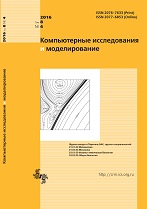|
MATHEMATICAL MODELING AND NUMERICAL SIMULATION
About the mechanism of switching between standing and traveling waves is accompanied by a halving of the wavelength
M. Yu. Borina, A. A. Polezhaev
P. N. Lebedev Physical Institute of the Russian Academy of Sciences
Russia, 119991, Moscow, Leninskiy prospekt, 53
Abstract:
We suggest a possible mechanism for the transition from standing waves with a wavelength $\lambda_{SW}$ to traveling waves with a half wavelength: $\lambda_{TW} \cong \lambda_{SW}/2$. This phenomenon was observed inthe Belousov–Zhabotinsky reaction dispersed in a water-in-oil aerosol OT/Span-20 microemulsion. The problem is solved in a spatially one-dimensional case using amplitude equations approach. We demonstrate that a transition is possible under certain conditions. We obtain conditions for the mode coupling strength parameters, under which the scenario of transition from a standing wave to a half-period traveling wave, observed experimentally, is realized. The result of theoretical analysis is confirmed by numerical simulations.
Keywords:
bifurcation, standing waves, traveling waves, amplitude equations.
Received: 21.06.2012
Citation:
M. Yu. Borina, A. A. Polezhaev, “About the mechanism of switching between standing and traveling waves is accompanied by a halving of the wavelength”, Computer Research and Modeling, 4:4 (2012), 673–679
Linking options:
https://www.mathnet.ru/eng/crm520 https://www.mathnet.ru/eng/crm/v4/i4/p673
|

| Statistics & downloads: |
| Abstract page: | 141 | | Full-text PDF : | 62 | | References: | 26 |
|




 Contact us:
Contact us: Terms of Use
Terms of Use
 Registration to the website
Registration to the website Logotypes
Logotypes








 Citation in format
Citation in format 